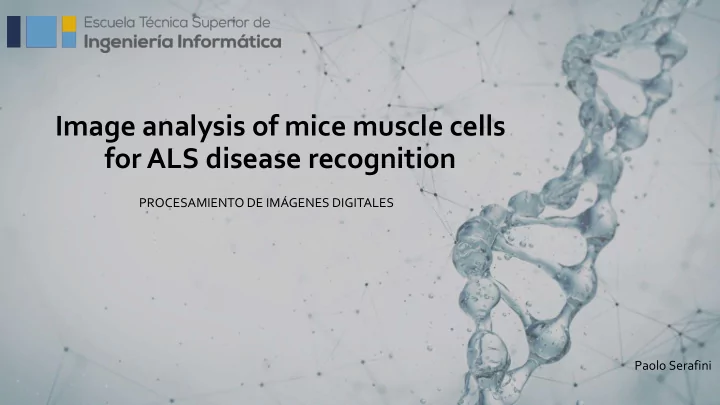

Image analysis of mice muscle cells for ALS disease recognition PROCESAMIENTO DE IMÁGENES DIGITALES Paolo Serafini
Introduction • • Healthy mouse Mouse with ALS (Amyotrophic lateral sclerosis) Mutation in the SOD1 genome and the G93A mutation (glycine 93 changed to alanine)
Image Folder Green Image Red Image Blue Image Edge Fast fibers Lens fibers Nuclei
Practical Resolution Green Image Red Image Blue Image 1. Greyscale 1. Greyscale 1. Greyscale 2. Combination of images 2. Binarization 2. Filtering 3. Binarization 3. Binarization 3. Combination of images 4. Segmentation 4. Division 4. Region computation 5. Region computation 5. Region computation
Red Combination Fast cells Green Segmentation Without borders Blue Binarisation Combination
Green image
From green image to green channel Green channel
Filtering The first approach after the greyscale transformation is the combination of two filters to smooth the image and incremented the cells division. 1) After median filtering 2) After static filtering
Binarization • DYNAMIC With Otsu’s method The binarization was made for the threshold through two different threshold methods: • STATIC With a cycle and a defined threshold Better result
Result after binarization NOISE inside the cells The result after binarisation shows a lot of noise inside and outside the cells NOISE outside the cells
Noise removal Sequence of removals: ➢ White connected components smaller than 500 ➢ Black parts with disk structural element ➢ All white noise inside the cells through filling ➢ Black connected components smaller than 1000
White connected component Removal of white connected components smoller than 500
Disk structural element Morphological operation of closing with a disk structural element of radius 30.
Filling operation Through the use of imfill function implemented on Matlab I was able to remove this white noise inside the cells. Previous image After the filling
Black connected component Remove of all connected component of the inverse image smaller than 1000 Final segmented image
Computation Used of functions: • Imclearborder • Regionprops: With this function is possible to compute Area, Convexity and Eccentricty of the cells
Red image
From red image to red channel Green channel
Combination Green binarized image Fast fibers Slow fibers Red channel
Computation Fast cells • Used of function Regionprops to establish the amount of fibers with a mean intensity smaller and greater than 50. • Removal of connected component which mean intensity is smaller than 50 • Computation of FAST and SLOW fibers
Blue image
Blue channels Green channel
Binarization and Segmentation Binarized image Image after the remove of all connected component smaller than 500
Combination Blue segmented image Result image to establish the number of NUCLEI inside the cells through the use of Green binarized image connected component
Nuclei • The total amount of nuclei is computed from the binarized and segmented image • The percentage is the amount of nuclei inside the cells divided to the total
Problem with binarization Green image Binarized image As we can see in this example the binarisation does not allowed a clearly separation of the different cells, due to a problem related to the thresold.
Solution and Conclusions To overcome the problem is possible to implemented a GUI with which the user could change the values of the different threshold and thanks to this he could improve the segmentation. Anyhow, many tissues studied resulted well segmented and the computation of their property was very precise. This work allows the scientist to obtain the different property of the cells ( Area, eccentricity, convexity, number of fast and slow fibres and number of nuclei inside the cells) and to start a study of that to understand the main characteristics that could establish if a Mouse is affected or not by the ALS.
References [1] Mauro Miazaki, Matheus P Viana, Zhong Yang, Cesar H Comin, YamingWang, Luciano da F Costa, Xiaoyin Xu .”Automated high -content morphological analysis of muscle fiber histology”. Computers in Biology and Medicine, Vol. 63, pp. 28 – 35, 2015. [2] MathWorks. (s.f.). bwconncomp. Link: https://es.mathworks.com/help/images/ref/bwconncomp.html [3] MathWorks. (s.f.). imhmin. Link: https://it.mathworks.com/help/images/ref/imhmin.html [4] MathWorks. (s.f.). regionprops. Link: https://it.mathworks.com/help/images/ref/regionprops.html [5] MathWorks. (s.f.). imfill. Link: https://es.mathworks.com/help/images/ref/imfill.html [6] MathWorks. (s.f.). medfilt2. Link: https://it.mathworks.com/help/images/ref/medfilt2.html [7] MathWorks. (s.f.). ordfilt2. Link: https://it.mathworks.com/help/images/ref/ordfilt2.html [8] MathWorks. (s.f.). imclearborder. Link: https://es.mathworks.com/help/images/ref/imclearborder.html
Thanks for your attention!! Any questions?
Recommend
More recommend